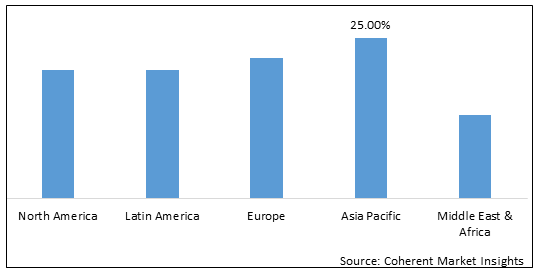The products made from animal hide by means of tanning, are referred to as leather goods. The process of tanning animal hide makes it suitable for various applications such as wallets, clothing, footwear, and others. The inherent qualities of leather such as dustproof, fireproof, crack-proof, and durability are expected to increase the growth of the Global leather goods market.
Global leather goods market was valued at US$ 2932.5 Billion in 2021 in terms of revenue, exhibiting a CAGR of 5.18% during the forecast period (2022 to 2030).
Drivers
Designers worldwide showcase new apparel through fashion shows and events, thereby attracting more consumers toward leather clothing For instance, in September 2020, the Forever Leather Fashion show was organized in Shanghai, China. The show displayed a variety of leather products, including a range of modern-style jackets, cross-stitched trench coats, travel bags, leather sneakers, duffel bags, and ankle boots. Such instances bring together hundreds of thousands of leather buyers, manufacturers, and designers from different provinces.
An increasing number of High-Net-Worth Individuals (HNWIs), coupled with the growing trend of designer and branded clothes in major markets, such as the U.S., France, and China, is boosting the demand for leather products. Leather goods are exclusive and often premium priced. The demand for leather products is significantly growing in China owing to the increasing number of High Net worth Individuals (HNWIs) and Ultra-High Net worth Individuals (UHNWIs) in the country. According to the Global Wealth Report 2019, published in October 2019, by Credit Suisse Group AG, in 2018, China had 10% of the world’s total HNWIs.
The COVID-19 pandemic has had a negative impact on the overall leather industry, including footwear, apparel, and accessories. Retailers faced severe losses during the first two quarters of 2020. According to a report by World Footwear in 2021, the sales of footwear declined by close to 32% in the U.S. at the end of 2020. Low demand for footwear, in general, is subsequently expected to decrease the sales of leather shoes. Many manufacturers in the industry have historically relied on China for finished products as well as raw materials used in the manufacturing of various leather goods. The pandemic has, however, disrupted the supply chain, causing severe losses in terms of product shipment and on-time delivery.
Figure 1. Global Leather Goods Market Value Share (%), By Region, 2021

To learn more about this report, Download Free Sample
Market Restraints
Low availability of raw materials, availability of synthetic alternatives such as plastic leather, and availability of leather goods at low cost are some of the factors restraining the growth of the global leather goods market.
Leather Goods Market Report Coverage
| Report Coverage | Details | ||
|---|---|---|---|
| Base Year: | 2021 | Market Size in 2021: | US$ 293.5 Bn |
| Historical Data for: | 2017-2020 | Estimated Year: | 2022 |
| Forecast Period 2022 to 2030 CAGR: | 5.18% | Forecast Period: | 2022-2030 |
| Geographies covered: |
|
||
| Segments covered: |
|
||
| Companies covered: |
LVMH Moët Hennessy Louis Vuitton SE, Kering S.A., Adidas AG, Hermès International S.A., Dolce & Gabbana Luxembourg S.à.r.l., Overseas Leather Goods Company Pvt Ltd, Tata International Ltd, Chanel International B.V., Prada S.p.A, and Ralph Lauren Corporation. |
||
| Growth Drivers: |
|
||
| Restraints & Challenges: |
|
||
Uncover macros and micros vetted on 75+ parameters: Get instant access to report
Market Trends
With the increase in disposable income of individuals, the demand for luxury goods has also increased. These goods often symbolize a sense of accomplishment within individuals, giving them higher self-esteem. Europeans and North Americans are known to spend most on luxury goods, owing to higher household income. An upward thrust can be seen in this matter in the Asian region as well. Leather goods form a major part of luxury goods. Luxury leather products include exclusive handbags, accessories, and shoes, which appeal to affluent individuals. In the case of the personal luxury segment, leather goods are the fastest-growing segment that attracts extravagant customers.
The growing government support for the leather industry is further driving the market growth. For instance, in India in 2020, foreign direct investment allowed for the manufacturing of leather products through an automatic route. Between April 2000 and September 2021, the cumulative Foreign Direct Investment (FDI) equality inflow in the case of the Leather, Leather Goods, and Pickers Industry was US$ 218.69 million.
Figure 2. Global Leather Goods Market Value Share (%), By Product Type, 2021

To learn more about this report, Download Free Sample
Recent Developments
Competitive Section
Major players operating in the global leather goods market include LVMH Moët Hennessy Louis Vuitton SE, Kering S.A., Adidas AG, Hermès International S.A., Dolce & Gabbana Luxembourg S.à.r.l., Overseas Leather Goods Company Pvt Ltd, Tata International Ltd, Chanel International B.V., Prada S.p.A, and Ralph Lauren Corporation.
Share
Share
About Author
Yash Doshi is a Senior Management Consultant. He has 12+ years of experience in conducting research and handling consulting projects across verticals in APAC, EMEA, and the Americas.
He brings strong acumen in helping chemical companies navigate complex challenges and identify growth opportunities. He has deep expertise across the chemicals value chain, including commodity, specialty and fine chemicals, plastics and polymers, and petrochemicals. Yash is a sought-after speaker at industry conferences and contributes to various publications on topics related commodity, specialty and fine chemicals, plastics and polymers, and petrochemicals.
Missing comfort of reading report in your local language? Find your preferred language :
Transform your Strategy with Exclusive Trending Reports :
Frequently Asked Questions
Select a License Type
Joining thousands of companies around the world committed to making the Excellent Business Solutions.
View All Our Clients